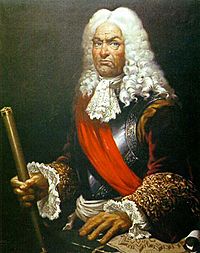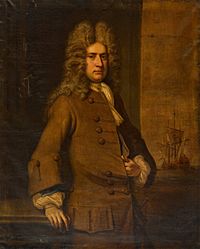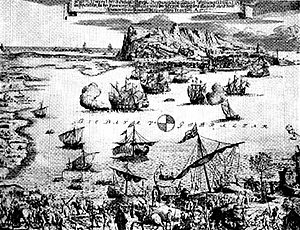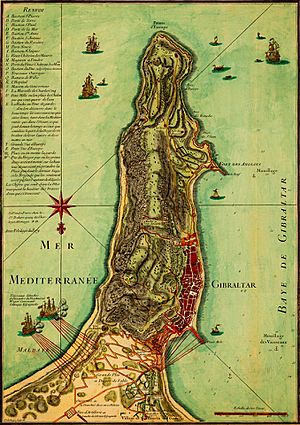Thirteenth siege of Gibraltar facts for kids
Quick facts for kids Thirteenth siege of Gibraltar |
|||||||
|---|---|---|---|---|---|---|---|
| Part of the Anglo-Spanish War (1727–1729) | |||||||
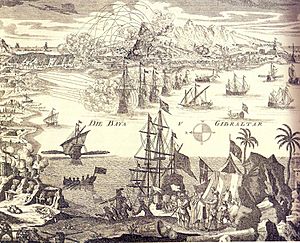 Die Baya v Gibraltar, unknown author |
|||||||
|
|||||||
| Belligerents | |||||||
| Commanders and leaders | |||||||
| Strength | |||||||
| 5,500 | 17,500 | ||||||
| Casualties and losses | |||||||
| 118 killed 207 wounded |
392 killed 1,019 wounded |
||||||
The siege of Gibraltar of 1727 (thirteenth siege of Gibraltar, second by Spain) saw Spanish forces besiege the British garrison of Gibraltar as part of the Anglo-Spanish War. Depending on the sources, Spanish troops numbered between 12,000 and 25,000. British defenders were 1,500 at the beginning of the siege, increasing up to about 5,000. After a five-month siege with several unsuccessful and costly assaults, Spanish troops gave up and withdrew. Following the failure the war drew to a close, opening the way for the 1728 Treaty of El Pardo and the Treaty of Seville signed in 1729.
Contents
Background
On 1 January 1727 (N.S.) the Marquis of Pozobueno, Spanish ambassador to the Court of St. James's, sent a letter to the Duke of Newcastle explaining why the Spanish Crown believed that Article X of the Treaty of Utrecht (the Article which granted Britain perpetual control of Gibraltar under certain conditions) had been nullified by infractions by the British:
The cession which his Majesty [King Philip V] made precedently of that Place is become null, because of the infractions made in the conditions on which it was permitted that the English garrison should remain in the possession of Gibraltar; seeing that contrary to all the protestations made, they have not only extended their fortifications by exceeding the limits prescribed and stipulated, but what is more, contrary to the express and literal tenour of the Treaties, they receive and admit the Jews and Moors, in the same manner of the Spaniards, and other nations confounded and mixed, contrary to our holy religion; not to mention the frauds and continual contrabands which are carried on there to the prejudice of his majesty's Revenues.
The letter was tantamount to a declaration of war. Spain, however, was not in a particularly advantageous position to capture Gibraltar in 1727. At the last attempt to retake Gibraltar in 1704, Spain had a strong navy and the additional assistance of French warships. However, following their defeat at the battle of Cape Passaro and the capture of Vigo and Pasajes, the Spanish Navy was severely weakened. The Royal Navy had complete naval supremacy in the Straits, ruling out a Spanish landing in the south, and ensuring that the British garrison would be well supplied through a siege. Also, any attempt to scale the Rock from the east (as five hundred men under Colonel Figueroa, led by a local goatherd named Susarte, had done in 1704) was now impossible as the British had destroyed the path. The only option of attack open to the Spanish was along a narrow funnel (reduced in width by an inundation) that ran between the sea and the western side of the North Face of the Rock. This narrow strip of land would come under fire from three sides: Willis's battery to the east, the Grand Battery to the south, and the Devil's Tongue Battery on the Old Mole to the west.
A number of Philip V's senior military advisers warned the King that the recapture of Gibraltar was, at the present, near impossible. The Marquis of Villadarias (who had led the previous attempt to capture Gibraltar in 1704) had warned that it would be impossible to take the Rock without naval support. The senior Flemish engineer, George Prosper Verboom, agreed with this opinion, and 'gave it as his considered opinion that the only plan with any possibility of success was of a seaborne attack from the south.' However, the King was impressed by the Count de las Torres de Alcorrín, Viceroy of Navarre, who vowed that he could: 'in six weeks deliver Spain from this noxious settlement of foreigners and heretics'. The disagreement between Verboom and de las Torres was to continue throughout the siege, indeed, so noticeably that later, when the siege was underway, a diarist within Gibraltar (the anonymous 'S.H.') wrote that a Spanish deserter had reported: 'that a dispute hath happen'd betwixt two Generals about storming us, upon which the one... is going to Madrid to complain to the King."
Opposing forces
Despite Verboom's doubts, the King gave de las Torres leave to attempt an assault on Gibraltar. The count began to muster the besieging troops at San Roque at the start of 1727, in total thirty infantry battalions, six squadrons of horse, seventy-two mortars, and ninety-two guns (although on occasion some heavier guns were brought from Cadiz). Large parts of the army were not themselves Spanish. Of the thirty infantry battalions nineteen were foreign mercenaries: three battalions of Walloons, three French Belgian, four Irish, two Savoyard, two Neapolitan, one Swiss, one Corsican, and one Sicilian. Serving alongside the Jacobite Irish was the infamous Duke of Wharton. Founder of the original Hellfire Club, Wharton had fled England (to escape his creditors following the South Sea Bubble stock market crash) and joined the cause of the Old Pretender. He attained permission from Philip V to serve as volunteer aide-de-camp to the Count de las Torres, and was something of an embarrassment to both sides. He was badly injured in the leg during the siege and he was later declared an outlaw by the British Government.
Both the Governor of Gibraltar (the Earl of Portmore) and the Lieutenant Governor (Brigadier Jasper Clayton) were in England when the Spanish began to amass their forces. Colonel Richard Kane, the British commander of Menorca, was in temporary command of the sparsely defended British garrison of approximately 1,200 men from the 5th Regiment (Pearce's, or the Northumberland Fusiliers – later the Royal Regiment of Fusiliers), the 13th (Lord Mark Kerr's, or the Somerset Light Infantry- later the Light Infantry), the 20th (Egerton's, or the Lancashire Fusiliers – later the Royal Regiment of Fusiliers), and the 30th (Bisset's, or the East Lancashire Regiment). Kane expelled the 400 Spanish residents of Gibraltar and continued to improve the defences until 13 February (NS) when Brigadier Clayton arrived with a fleet under Admiral Sir Charles Wager and reinforcements from the 26th Regiment (Antruther's, or the Cameronians), the 29th (Disney's, or the Worcester Regiment – later known as the Worcester and Foresters Regiment), and the 39th (Newton's, or the Dorset Regiment – later the Devon and Dorset Regiment).
By early February, Spanish labourers had moved down from San Roque to the isthmus and started to construct battle lines. On 22 February (NS) a warning shot was fired over the heads of the working parties. 'The Governor gave them a Gun, at Four O'Clock, by way of Challenge, and, in an hour, Canonaded them very warmly.' Thus the thirteenth siege began.
Gibraltar under siege
The early siege
The Count de las Torres's first move was, by cover of night, to move five battalions and 1,000 working men forward to take the Devil's Tower and two other abandoned fortifications, and to dig trenches parallel to Gibraltar's walls. Until the invention of the Koehler Gun in the Great Siege (1779–1783), fixed artillery guns could not be depressed below the horizontal, so the Spanish working parties could not be fired upon from the North Face of the Rock. The finished trenches might have provided the attackers with a good foothold from which to assault the town. However, 'Admiral Wager moved his squadron out of the bay to the eastern side of the isthmus, and at point-blank range, yet beyond the reach of the Spanish guns, pounded the men with enfilade fire for three days, inflicting on them perhaps more than 1,000 casualties.' The Spaniards soon built batteries to drive away Wager's ships, but even without naval bombardment the strong winds and heavy rain of February made digging and maintaining the trenches nearly impossible.
Willis's battery, on the North Face of the Rock, gave the Spaniards a great deal of trouble. After a natural cave was discovered in the Rock, a plan was hatched to mine under Willis's Battery and 'excavate a gallery 1.5 metres wide and 1.7 high to a depth of about 25 metres, then a further 20 upwards, and to fill the cavity with 400 barrels of powder.' This activity was noticed by and alarmed the defenders:
They possest themselves of a Cave, under the Rock, in order to undermine it, so as to get into the Town; upon discovery ... our Men made a mine over their Heads and blew up the Rock upon them.
A machine was invented to let a man down the side of the Rock to spy what the Enemy were doing. This was put into execution, in the Night too, with no effect, for the unevenness of the Rock prevented any safe decent, so that we could make no discovery how they propos'd to blow it up.
However, the limestone under Willis's battery was far too solid to mine easily 'in less than the space of eight or ten months and a hazard whether it could be perfected even then or not.'
First heavy bombardment
Failing to create a strong stepping stone for a land assault, and lacking the means for an assault from the sea, de las Torres's only option now was to pound the British into surrender. On 24 March (NS) the Spanish began what they hoped would be a decisive bombardment:
Prodigious firing all last night ... The Spanish General, it seems, has alter'd his opinion of the Rock, and it seems too hard of Digestion, tho' he has a good stomach to it, yet he is too impatient to wait two years to eat a passage to us that way.
Another contemporary account acknowledged that from this point 'it might rightly be said that ours was a gunner's war. We could do nothing but receive the enemy's fire and return it.' The Spaniards did great damage to the northern part of the town, the affluent Villa Vieja, and 'a hundred houses were by that means laid in rubbish.' After the siege the ruins were removed to create present-day Casemates. Despite the structural damage there were few casualties. The greater concern was the number of men the British had available to man the guns, repair the damage to the fortifications, and serve on sentry duty. This proved to be a major problem for the garrison.
The Spanish bombardment continued for ten days. In his entry for 24 March (O.S.) 'S.H.' noted: 'last three Days very heavy rains and some Wind.' The terrible weather caused great problems for the besiegers in the trenches beneath the rock, and the Spanish had to ease their bombardment. A Spanish official journal published in Madrid in 1727 highlights the problems the besiegers were suffering and their frustrations:
Desertion becomes very considerable, the troops greatly diminished by sickness. Some fresh troops are coming from Malaga to ease those in camp who are greatly fatigued by hard duty: no sally yet made from the town, as the constant rains have hindered the advance of our works and it is supposed they [the British] thought their artillery sufficient to check our progress. We have yet dismounted only three of their cannon on the curtain and deserters say they have not had above 15 men killed yet.
Reinforcements arrive
During this relative lull in the Spanish bombardment, much needed reinforcements arrived in Gibraltar. On 7 April (N.S.) the 25th (Middleton's, or the King's Own Scottish Borderers) and 34th (Haye's, or the Border Regiment – later the Royal Border Regiment) Regiments arrived with a 480-strong detachment from Menorca. Then on 1 May (NS) the Governor, the Earl of Portmore, arrived with ten companies of the First Guards and the 14th Regiment (Clayton's, or the West Yorkshire Regiment – later the Duke of Wellington's Regiment). Room was made for the new reinforcements by moving troops south. 'Tents were fix'd toward Europa Point and three Regiments encamped to make room in the Town for Middleton and Hayes's who disembarked this day.' Camp Bay derives its name from this siege, when a regiment was encamped above it. 1727 also saw the destruction of the trees which grew on the Rock:
Many trees and vines flourished upon the Mountain when the Spaniards attempted to surprise the garrison over the middle hill [1704]; and many continued till the year 1727, when the regiments who were encamped to the southward had leave to cut some for their firing, which they took in its full latitude and levelled almost the whole.
One of the few sorties of the siege occurred just before the arrival of Lord Portmore. An ingenious plan devised by Clayton, it failed due to the gunners acting too soon.
Second heavy bombardment
By 7 May (N.S.) de las Torres was ready to launch another heavy bombardment. This caused major damage to the town and batteries, and caused far more British casualties than any earlier point in the siege.
The recently arrived British reinforcements, however, allowed the garrison to maintain the batteries, re-mount the guns, and return fire. Lord Portmore, in an attempt to boost the morale and productivity of his infantry turned labourers, increased their pay from eight pence to a shilling a day.
The firing from the Spanish guns began to slacken. After several days' continuous fire the Spanish iron cannon began to burst, whilst the better brass cannon began to drop at the muzzle from overheating. The besiegers were also beginning to suffer from a lack of supplies owing to the poor Andalusian roads. 'Another deserter confirms their being in a miserable state of Health, with great want of Water and Provisions.' The garrison, on the other hand, had ample supplies of provisions, guns, and powder from the sea, and soon began to outgun the Spaniards. The Spanish continued to fire upon Gibraltar, but 'S.H.' wrote: 'We laugh at them for Fools to throw away their Powder Ball and Shells, since they neither fright, kill or hurt us.'
End of hostilities
Frustrated with the Count de las Torres's obstinacy and inability to take his advice, the Spanish senior engineer, Veerboom, had left for Madrid. His proposed overland attack from the north failing, de las Torres asked his remaining engineers (Francisco Monteagut and Diego Bordick) for their opinion. Their response was blunt:
Had we found ourselves in such a position as to be worthy of being asked our opinion of the enterprise before the siege began, as we are now to be worthy of being consulted by your Excellency over its prosecution, we would have voted on nothing more than a diversionary tactic overland ... [the geography and defences of Gibraltar] all combine to make a counter-attack so manifestly unbeatable
On 23 June (N.S.) the Spanish offered a truce.
This night a Colonel of Ireland came to the Head of the Prince's Line and called to let them know he had a letter for Lord Portmore, but the commanding officer let him know unless retired they wou'd fire at him [all parleys between the two forces were supposed to come by sea]. Sometime after the same person came out of the zigzag [trenches] beating a chammade and was admitted into the town and deliver'd Lord Portmore's letters from M. Van der Meer, Minister of the States at the Court of Spain with a copy of the preliminary articles signed by the plenipotentiaries of the several powers of the two alliances for a suspension of arms whereupon his Lordship agreed to it and all hostilities ceased on both sides.
The next day a Colonel from the garrison crossed to San Roque, where a truce was agreed. The Spaniards were to remain encamped outside Gibraltar, but hostilities were to cease. An uneasy truce remained until the end of the Anglo-Spanish War in 1729.
See also
 In Spanish: Sitio de Gibraltar (1727) para niños
In Spanish: Sitio de Gibraltar (1727) para niños


